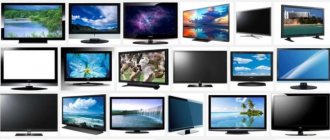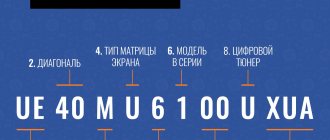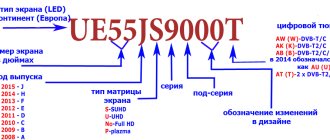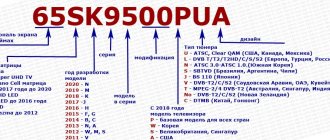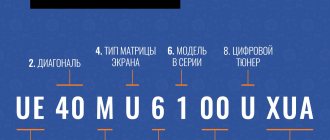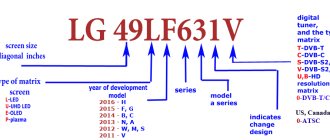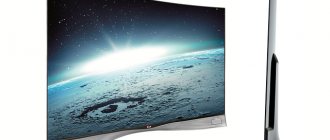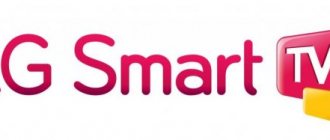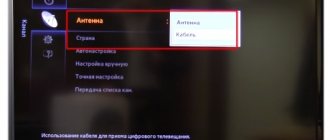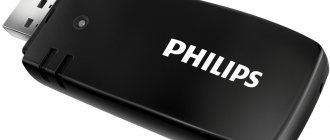As you already understood from the title of this publication, it will talk about what decoding of Samsung TVs is included in this or that model range from the manufacturer. It should be said that we will consider the generally accepted markings for the 2012 and 2013 models, and for some earlier models the decoding may be different. But be that as it may, you are unlikely to find such old models in stores, but you will certainly know what is included in the labeling of modern Samsung TVs. In addition, you can independently determine to which type or region a particular model belongs.
As a rule, the model code can be found on the nameplate, which is located on the back wall of the television panel or in the documentation attached to it. Unfortunately, most buyers pay attention to the marking of the TV after the purchase, but if you have not yet made your choice, then knowing the principle by which Samsung TVs are marked you can make the right choice. An example of marking is shown in the image.
By the way, read here about what you should pay attention to when choosing an LED Smart TV with 3D technology, and read here about how to check it yourself for dead pixels. If you are interested in what principle the 3D playback technology on TVs works on, then read about it here.
Decoding of Samsung TV models 2012.
So, since 2008, a common label has been adopted for the model range of Samsung TVs, and we will begin to consider it with the 2012 model range using the example of the UE40ES6307UXRU TV.
— The first letter in the model code indicates the type of backlight:
U - (LED - Light-Emitting diode) - LED backlight K - (OLED - Organic Light-Emitting Diode) - organic light-emitting diode P - (PDP - Plasma Display Panel) - plasma panel L - (CCFL - Cold Cathode Fluorescent Lamp) - The matrix is illuminated using cold cathode fluorescent lamps. C - (CRT - Cathode Ray Tube - cathode ray tube) - kinescope models, which are already a thing of the past.
— The second letter indicates the continental origin of the Samsung Smart TV model.
E - Europe A - Asia, Africa, Australia S - Iran N - Korea, North and South America
— Next comes a digital designation that indicates the screen size. As a rule, screen size is measured in inches and in the model code marking, it is also written in inches. Here are the most popular model diagonals at the time of writing:
32, 40, 42, 46, 50, 55, 60, 65. There are other diagonals.
— Next comes a letter that indicates in what year the TV was born.
A - 2008; B - 2009; C - 2010; D - 2011; E - 2012; F - 2013...
It should be said that in 2012, Samsung added one more to the existing letters. For example, S (ES) was added to the letter E, where S indicates that the TV is thin, and the letter H (EH) indicates that this model is of standard thickness (budget option).
— What follows are four numbers that inform you about the following:
The first one means serial affiliation (4, 5, 6, 7, 8, 9). Briefly about serial capabilities.
4 — the series has standard functions, has a USB connector and can play movies from a flash drive (here it is written on what principle USB flash drives work, and here read how flash memory works). This series receives broadcast and cable broadcasts.
5 — the series has several USB connectors and already supports Full HD screen resolution (1920×1080). It is possible to connect to the Internet via a LAN port and watch videos online. You just need a patch cord for this. If you don’t have it, then you can do it at home without special equipment. tool to crimp the twisted pair. In addition, these models accept terrestrial and cable broadcasts of the DVB-T2 standard.
6 — the series also has several USB connectors, HDMI, has a 3D function and can connect to the Internet not only via Ethernet, but via Wi-F (read here about how to connect Smart TV to the Internet via a LAN cable, and here it is written how to connect TV via Wi-Fi). In addition to cable and terrestrial television, they can receive satellite broadcasts. Built-in DVB-S2 tuner.
7 - these models are superior to their predecessors, as they have improved technology. In addition to the mentioned connectors (USB, HDMI), video (D-sub) has also been added. They also support 3D and LAN functions, Wi-Fi connection to the Internet. Has a universal DVB-T tuner | DVB-T2 | C | S2. By the way, this and the previous series can be connected to a computer using AllShare (Samsung Link) programs to broadcast video content to Smart TV (here it is described how to connect a computer to Samrt TV using AllShare).
8, 9 is a mega series with a 2-core processor (ARM architecture (Dual-core) and Cortex-A9 cores, 1 GHz) and a 4-core processor (ARM architecture and Cortex-A15 cores, 1.35 GHz). The processor can be replaced with a new one thanks to Samsung Smart Evolution Kit technology. Which will certainly add functionality to your Smart TV. Of course, it supports many different functions and the HbbTV standard, as well as 3D images. There is a DVB-T/DVB-T2/C tuner.
In one of my comments, I once said that Smart TV has not yet become a computer - it seems I was wrong. Samsung has taken a sharp step forward, as evidenced by the official video. Samsung Evolution Kit is already available for 2012 series 7 and 8 models (compatible with 2012 series LED ES7500 and above models, PDP - E8000) released for sale in Russia.
With this innovative solution, you can get all the new features and technologies that are included in the 2013 models. Samsung says that the module will continue to be produced, as it will save Samaung Smart TV owners from purchasing a new model and will help upgrade a previously purchased model.
Second , this number in the marking indicates the sub-series of the model. Samsung does not particularly talk about the exact meaning of the number, but according to some experts, it may contain significant differences in technical performance in this series. Whether this is true or not, I cannot say, but if you have anything to add to this point or the material itself, then you are welcome to comment on the article.
Third , this figure does not affect the technical characteristics of the model in any way, but only informs about minor changes in the model in terms of design (color, case...).
The fourth indicates the presence and type of tuner. It should be said that in the 2012 model series, for example, 0 (zero) indicated that a DVB-T type tuner was installed, and the number 7 (seven) indicated the presence of a DVB-T2 type tuner.
In some of the same 2012 models, there may be letters after the numbers and before the delivery region code (read about the decoding of regional delivery below). According to Samsung support service, the letter(s) in the marking are a service name and they do not carry any meaning for consumers. For example, UE46ES6307 and UE46ES6307U or UE65F6400 and UE65F6400AK, this is the same model and the U/AK symbol does not contain anything except the service name.
Whether this is true or not is difficult to say, because there is no official and intelligible answer to this index anywhere, and on the forums everyone has their own opinion. But if you want to figure it out yourself, then you can try to compare the models you are interested in with and without a letter index according to the available characteristics in some online store. And leave the results you received that will refute or confirm the words of the support service in a comment. Thus, together, we can try to establish the truth.
— Regional supply index.
The last three letters on the nameplate are a code that indicates for which country this model was produced.
XRU - Russia XUA - Ukraine XCS - Kazakhstan XZF - France XXU - England XZТ - Italy XXC - Spain XZA - USA XXY - Australia XMA (XXM) - Malaysia XZN - Arab countries XXT - India, Thailand XMS - Asia XZG - Germany, Austria and Switzerland XXN - Belgium, Holland, Luxembourg XBT - Baltic (Lithuania, Latvia, Estonia) XXE - Norway, Sweden, Denmark, Finland XXH - Eastern Europe (Slovakia, Hungary, Poland and so on)
Now let's decipher the model in question, which I mentioned at the very beginning, UE40ES6307UXRU.
U - LED backlight E - European continent 40 - diagonal in inches ES - 2012, thin 6 - sixth series 3 - subseries three 0 - color 7 - DVB-T2 tuner U - service name (does not matter to the consumer) XRU - model released for Russia.
This is the principle used to decipher the labeling of 2012 Samsung TVs.
Deciphering the labeling of Samsung TVs 2013.
I have already said that the main markings for Samsung TVs have remained unchanged since 2008, but at the same time there are some differences for the 2013 model range. They will be discussed further, and for the rest of the information you are interested in, see above. In general, changes in the marking of the F series affected only the designation of tuner formats. Now Samsung denotes them using letters.
AW - DVB-T/C; AB - DVB-T2/С/S2; AK - DVB-T2/C; AT - 2 x DVB-T2/C/S2; SB - DVB-T2/C/S2, SS - DVB-T/C/S2; ST - 2 x DVB-T2/C/S2; SL - 2 x DVB-T/C/S2;
It must be said that this Samsung label applies to TVs produced for Russia, Poland, Hungary, Slovakia and does not apply to countries such as Mexico, Korea, China and the UAE.
AF - DTV Tuner/Digital Cable Tuner/Analog Tuner; AR - DTV Tuner/Analog Tuner.
This marking applies to countries such as Korea, USA, Mexico... Explanation of the F series using the example of the UE50F6650AB model.
U - LED backlight E - European continent 50 - diagonal in inches F - 2013 release 6 - sixth series 6 - subseries (the higher the class, the better) 5 , 0 - the third and fourth digits mean color, type of stand and changes design. AB - presence of a digital tuner of the DVB-T2/C/S2 standard.
Now, I will briefly talk about the F series (2013). Of course, I will not describe the merits of each model, but keep in mind that in each series I described, there are TVs that were deprived of certain functions or technologies. To study in detail the capabilities of a particular F series model, I recommend that you read the detailed specifications on the manufacturer’s website.
4 — the series has Wide Color Enhancer Plus technology, which expands the range of color rendering and conveys color depth and hard-to-see shades. This series also uses Clean View technology, which is designed to automatically eliminate digital and analog noise, which certainly protects against interference and distortion. Clear Motion Rate100 technology provides clear transmission of dynamic scenes.
Some models have a Sports Mode that creates a stadium-like effect while watching sports. This series can play video content through a single USB port, and also has HDMI inputs (you can connect a game console, computer, and so on). There are models in this family that make it possible to record the broadcast and then play back the missed football or TV show.
Some models in this series have a built-in Wi-Fi module and a very good Internet browser (browser). For various entertainment, there is the SamsungTVApps application store (the article uses the E-2012 series model as an example, talks about the SamsungTVApps application). The series supports the second generation of digital television standard DVB-T2, 3D playback and surround sound.
5 — the series has the same technological and functional advantages and higher resolution. All models have Internet access, but some do not have a built-in Wi-Fi module. This line adds BlackOptimizer technology, which is designed to optimize black shades. The series has improved the clarity of moving objects using Subfield Motion Technology.
This technology increases the frame/half-frame rate by 600 times, which eliminates trailing behind moving objects in dynamic scenes, even in 3D. All models support AllShery technology (there is a link in the article above on how to set up a connection with a computer), which makes it possible to exchange files with other devices (tablet, laptop...). The series also supports the DVB-T2 standard.
6 — the series as a whole has a number of technological advantages over previous series, but not all models reproduce 3D and surround sound. This line includes models that allow you to control your TV via voice. That is, you pronounce the “command” into the microphone of the remote control or the TV itself, and your Smart TV obediently obeys.
The series supports Wide Color Enhancer Plus (extended color range), Sports Mode (sports atmosphere), HyperReal Engine (image processor) and many different functions. For different models in the line, the technology for transmitting motion ClearMotionRate 400 and ClearMotionRate600 (transfer of dynamic scenes) has been improved. Of course, there is access to the Internet, and the UE F6100AK model has the ability to pause the broadcast.
7, 8 — series, these are generally digital monsters. Here it would probably be easier to say what is not here than to list all their capabilities. In short, these models implement everything that is in the previous series. In addition, the ability to manipulate gestures has been added to voice control. Gestures let you scroll through web pages, launch apps, and adjust volume.
A new Ultra Clear Panel technology has been implemented, which eliminates glare from any light sources. They also have a built-in camera, which makes it possible to communicate via Skype. In general, there is everything that is inherent in the previous series... And again, before you go to the store to make a purchase, check out the main characteristics of the model in the series you have chosen on the official website.
This is where I will end the publication. Now you have an idea of how Samsung TV models are deciphered. I do not specialize in the field of markings and decoding of Samsung TV models, but I tried to present what I know in a form accessible to you. I hope I succeeded. And if you can add anything to the publication or provide some clarity, welcome to comment.
Subscribe to new blog articles, there will be many more interesting things ahead. See you soon. Bye!
Series
Next, the user can decipher the series and subseries of the television receiver in the marking. The designation uses 3 symbols, each with its own meaning:
- The first digit indicates the series; a digital character set from 4 to 9 is used. And the higher the series value, the more they differ in the set of modern technologies and functions;
- The second means podcast series. Experts say that Samsung uses this data to indicate technical characteristics. There are no comments from the manufacturer regarding the meaning of the second digit of the series;
- The third digit indicates model design data.
